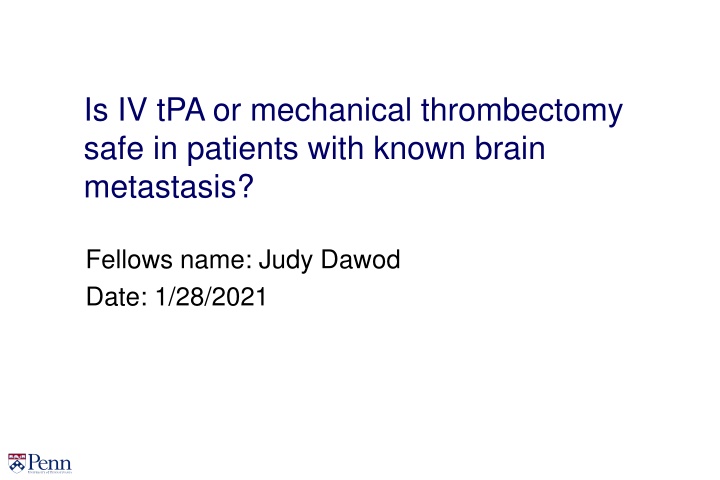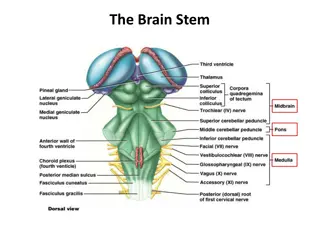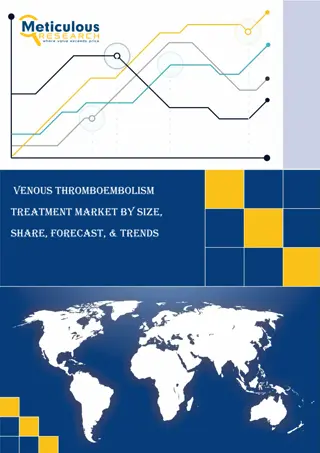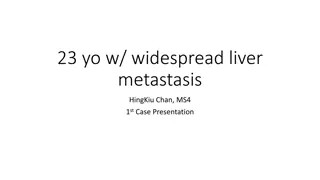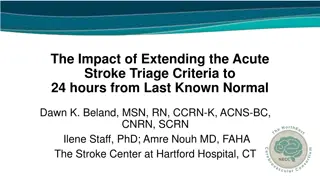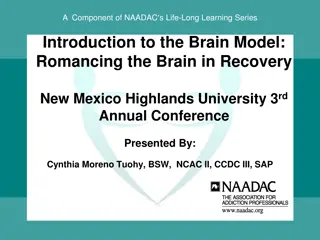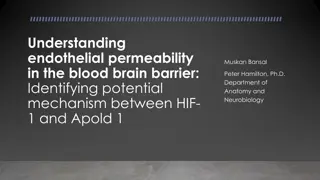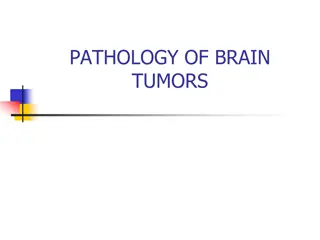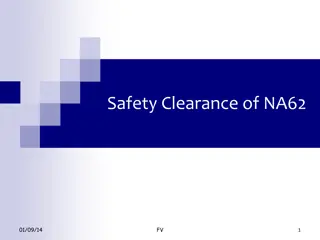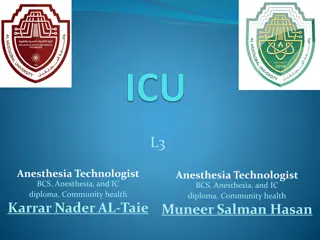Safety of tPA and Mechanical Thrombectomy in Brain Metastasis
A systematic literature review investigated the safety of thrombolysis in brain tumor patients, showing varied outcomes and intracerebral hemorrhage rates. Inpatient outcomes of thrombolysis for acute ischemic stroke in primary brain tumor patients were also analyzed. Hemorrhage rates in different brain tumor subtypes were examined, highlighting variations among metastatic lesions. Mechanical thrombectomy outcomes in cancer patients were discussed, although specific data on primary brain tumors was lacking. Overall, the studies provide insights into the safety and efficacy of thrombolytic therapies in the context of brain metastasis and primary brain tumors.
Download Presentation

Please find below an Image/Link to download the presentation.
The content on the website is provided AS IS for your information and personal use only. It may not be sold, licensed, or shared on other websites without obtaining consent from the author.If you encounter any issues during the download, it is possible that the publisher has removed the file from their server.
You are allowed to download the files provided on this website for personal or commercial use, subject to the condition that they are used lawfully. All files are the property of their respective owners.
The content on the website is provided AS IS for your information and personal use only. It may not be sold, licensed, or shared on other websites without obtaining consent from the author.
E N D
Presentation Transcript
Is IV tPA or mechanical thrombectomy safe in patients with known brain metastasis? Fellows name: Judy Dawod Date: 1/28/2021
systematic literature research of electronic databases covering the period from 1990 to 2012 12 patients with different brain tumors who were treated with thrombolysis for different reasons Brain tumors included 6 meningiomas, 2 glioblastomas, 1 schwannoma, 1 low-grade astrocytoma,1 pituitary adenoma, and 1 brain tumor without furtherdetails Intracerebral hemorrhage occurred in 1 patient (8.3%) with a glioblastoma, and in the other 11 patients (91.7%), no hemorrhage was documented Thorleif Etgen et al,Thrombolysis for Ischemic Stroke in Patients with Brain Tumors, Journal of Stroke and Cerebrovascular Diseases. February 2014, Pages 361-366
Patients with acute ischemic stroke who received thrombolysis were identified from the 2002-2011 USA Nationwide Inpatient Sample Of the 124,083 thrombolysis-treated stroke patients, 416 (0.34%) had brain tumors. In adjusted analysis, inpatient mortality, rate of home discharge, and rate of ICH were similar between benign BTS and NBTS Analysis of brain tumor subtypes showed that compared to NBTS, malignant BTS were independently associated with higher in- hospital mortality, lower home discharge, and increased risk of ICH Additionally, among the BTS, intraparenchymal location of tumor was associated with higher mortality and lower home discharge Santosh B Murthy et al, In-hospital outcomes of thrombolysis for acute ischemic stroke in patients with primary brain tumors, J clin neurosci. 2015 Mar; 22(3):474-8
Combined macroscopic and microscopic hemorrhage rate was 29.2% for mixed oligodendroglioma/astrocytoma, 19.3% for glioblastoma, 12.5% for astrocytoma, and 2.8% for meningioma Among metastatic lesions, melanoma showed the highest rate of hemorrhage (50%) Metastatic adenocarcinoma, squamous carcinoma, and anaplastic carcinoma had significantly lower bleeding rates Although choriocarcinoma is often reported to have intratumoral hemorrhage, no cases were documented in the present study Douglas Kondziolka, Significance of hemorrhage into brain tumors: clinicopathological study, journal of neurosurgery, dec 1987
Mechanical thrombectomy There are many article s for MT in patient with active cancer, all showed worse outcome, less likely to be discharged home and less likely to be independent Risk of hemorrhage was not higher for patient who have active cancer No articles about MT in primary brain tumors or mets
